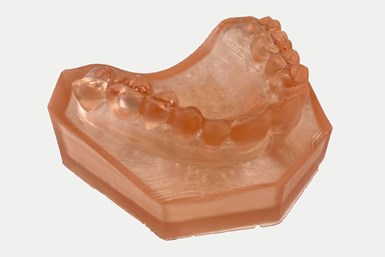PostProcess Technologies’ Resin Removal Detergent Achieves Biocompatible Standard
Company says integral component of proven automated postprinting solution achieves new standard for use in medical and dental fields.

Dental part
PostProcess Technologies Inc., a provider of automated and intelligent postprinting solutions for industrial 3D printing, has achieved compliance with ISO standard 10993 for evaluation of biocompatibility of its resin removal detergent PLM-403-SUB, as validated by Toxikon Corp. The detergent serves as an integral part of the company’s comprehensive, automated resin removal solution, the company says.
The detergent’s demonstration of compliance with requirements for biocompatibility means that additive manufacturers looking to maintain or incorporate fully biocompatible processes can seamlessly incorporate this resin removal solution into their workflow. The company says this will be a particularly impactful new industry standard of postprinting for those in the dental and medical fields.
The detergent is said to play a significant role in PostProcess’ Submersed Vortex Cavitation (SVC) technology, which utilizes established software intelligence to ensure that 3D printed parts are uniformly, consistently and reliably exposed to detergent as they undergo postprinting for precision finished parts. This technology can be a definitive industry solution for a safer, more efficient postprinting process that promotes sustainability, even as production volumes scale, the company says.
“We’ve always made seamless integration and dependability of our solutions a priority,” says Matthew Noble, Ph.D., PostProcess Technologies’ lead chemist. “With this compliance of biocompatibility, additive users can enjoy the efficiencies of automated resin removal as the new industry standard, and rest assured that their workflows and final products will meet necessary biocompatibility standards in a manner more sustainable than current market alternatives.”
Related Content
-
3D Printed Spine Implants Made From PEEK Now in Production
Medical device manufacturer Curiteva is producing two families of spinal implants using a proprietary process for 3D printing porous polyether ether ketone (PEEK).
-
3D Printed PEEK Spine Implants in Production: The Cool Parts Show Bonus
Curiteva is using Fused Strand Deposition to produce two different lines of FDA-cleared spine implants. We visited the company’s Huntsville, Alabama, facility to learn more.
-
Stryker Using Additive for Implants
Using its “AMagine” process, Stryker creates components with a titanium alloy that mimics bone.











